Tolkien: A Dedication to the Craft
When worldbuilding takes on a whole new meaning and begins transcending time, language, age, and more.

Nowadays, there isn't a single person in the world who doesn't know of the famous and critically-acclaimed trilogy The Lord of the Rings.
While this can also be said of big fantasy blockbusters such as Harry Potter and Game of Thrones, a significant difference between the three remains—something that sets J.R.R. Tolkien's life work apart from the rest, something that allowed it to rise to a distinguishable literary level.
A lifetime of dedication.
Creating a story from his mythology (and not the other way around)
J.R.R. Tolkien was many things before he became a writer—a scholar, an academic, a poet, a philologist, a husband, a father. His mind was vast, brimming with ideas that needed to be immortalized onto paper so they could be read, told, sung and not only to himself, but to others.
Tolkien's journey with high fantasy began in 1914, when he wrote a poem called 'The Voyage of Éarendel the Evening Star'. He didn't have any plan nor vision for it—at the time, the poem was nothing more than musings of light and darkness, but in those few lines, the first fragments of Middle-earth were born.
In the years that followed, Tolkien began working on his own mythology, slowly nurturing a world of elves, gods, and wizards. He developed an early form of his inflected language, Quenya, which would later on evolve into Sindarin, or the Elven-tongue we know today. Yet, the idea of creating unique creatures wouldn't enter his mind until the summer of 1930, while grading a pile of written exams. As he was studying a particular student's answers, he suddenly paused, noticing one of the pages had been left blank. For one reason or another, he began to write, his pen scratching away and staining white paper with ink.
In a hole in the ground there lived a hobbit.
The best part of this is Tolkien had no idea what a hobbit was, or why it even lived in the ground. All he knew was his mind had spoken, struck with inspiration before Tolkien himself could realize it. It would take six years for him to finish the manuscript for The Hobbit, in which he had dropped bread crumbs of his carefully crafted mythology, and another year to publish it, hot off the press and right into people's hands.
Its success was quick and indisputable, and his publisher, Stanley Unwin, promptly asked for more material. Tolkien, eager to share more of his mythology with the world, put together The Silmarillion, a book of various myths and legends of Middle-earth, notably the origins of the elves. That novel, however, was not as well received as his previous one, as most claimed it to be too poetic of a prose to commercially do well.
Tolkien deflated at the public's response, but was prompted by his publisher to continue the hobbit's tale. And so Tolkien sat down, put his glasses on, and began to write a sequel.
One he would title: The Lord of the Rings.
The art of character creation

Arguably the most important character in the entire trilogy. While Sam and Frodo undoubtedly have their respective roles to fill, there's a distinct difference between them and Aragorn.
Unlike others in the story, Aragorn is the epitome of an active character—things don't happen to him, he makes things happen. In The Fellowship of the Ring, he meets up with Frodo Baggin's company and takes it upon himself to guide and protect them until they reach Rivendell. In The Two Towers, he decides to stray from the original quest and chases after a horde of orcs to rescue Merry and Pippin, two hobbits whose purpose weren't yet fully defined. On countless occasions he is seen setting himself and his own life aside to fight for the common good. He is the definition of a selfless man, and that's why people are drawn to him.
"Aragorn, they cannot win this fight. They are all going to die!"
"Then I shall die as one of them!"
Aragorn, despite having a longer life span, is entirely human. He doesn't have Legolas' natural elvish advantage, or Gimli's warmonger ancestry. He doesn't possess celestial power like Gandalf, or immortal wisdom like Galadriel. Instead, what he knows, he learned from experience. From the failures and modesty that comes with the mortality of men.
Aragorn is not a flawless character, otherwise there would be no point in following his story. He is clever, yet isn't afraid to ask for his friends' council. He is a skillful fighter, but still falls to what, under different circumstances, might've been his death during the ambush on the Rohan refugees. His character development is masterfully done—he goes from a lone ranger terrified of following his forefather's dark steps, to becoming the leader he was always meant to be.
Without Aragorn, The Lord of the Rings would've been a very different tale.

Eowyn, though she may not be in everyone's good graces, is a character that bent the stereotypes and gender norms of the time. Let's backtrack for a moment and remember that LotR was being written between 1936 and 1948, a time frame set right before, during and after World War II. That period was critical for women's right, as that was when female labor globally saw a significant increase.
If you ask me, that pivotal point in history surfaced through Eowyn's character. She was noble and fair, but defied what was expected and acceptable of a woman of her status. Eowyn supported her family, accepted her responsibilities as the niece of a King, put her people safety's first, and still saw the opportunity to do more when she geared up and rode for the Battle of the Pelennor Fields. Without particular strength, skill or influence, she drew from the biggest tool at his disposal—her bravery.
The fact that she was the one to defeat the Witch-king of Angmar is merely a manifestation of that courage.

On a completely different plane of characterization is Gollum, also formerly known as Smeagol.
Gollum is unique, refreshing, compelling. He was created to take the audience by surprise, scare them, even blindside them with unexpected pity and compassion. I truly believe this was Tolkien's way of breaking the rules, starting with a blank canvas and letting his creativity run completely free. No matter who you are, you probably found yourself rooting for Smeagol at one point or another despite all the corruption and harm he had done. Ultimately, that's what Tolkien was going for when he created him—the embodiment of a contrast strong enough to evoke both love and hatred among readers.
Depending on how you decide to look at it, you can observe one of two clear desires during Gollum's journey with Frodo and Sam—to reunite with his precious, or, and that is true only when Smeagol is in control, to get rid of his alter ego and live a happier life.
In the end, he fails on both accounts, and that makes his story all the more interesting.
A tale to rule them all
Although it took the shape of a trilogy instead of the initial poetic vision, Tolkien was able to share his mythology through The Lord of the Rings, creating over nine hundred characters which spread through thousands and thousands of years worth of history.
The story of Middle-earth is a complex one. It is a tale of light and darkness that unwittingly began in 1914 and evolved into a universe epic enough to be adapted into movies, musicals, video games, and tv series all the way into the twenty-first century.
Over fifty years after the initial publication of LotR, Tolkien remains a praised and respected figure of English literature and is still known as the father of modern fantasy. While mythical creatures like elves, dwarves, dragons, orcs or trolls already existed when Tolkien began working on his manuscript, he was the one who re-popularized them. He revolutionized high fantasy and molded it into the popular genre we now all love.
Without his work, perhaps we would have no Witcher, no Harry Potter, no Game of Thrones to enjoy today.
Let me leave you with this absolute gem of internet culture (you're welcome)
About the Creator
Elsa Fleurel
veterinary technician and freelance writer
🌧 penchant for horror, thriller and criminal psychology 🌧
-
follow me on instagram






Comments
There are no comments for this story
Be the first to respond and start the conversation.